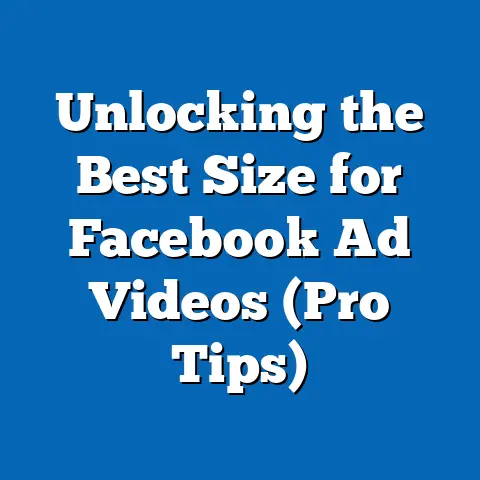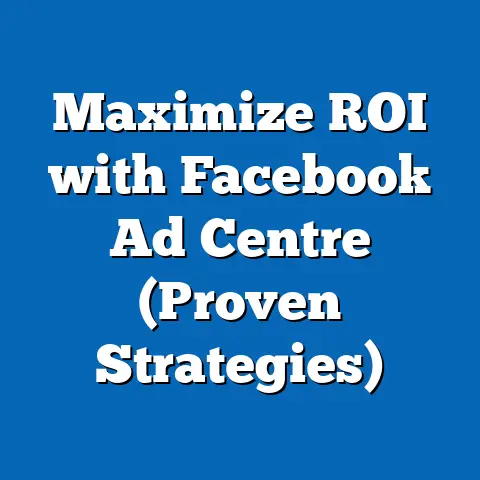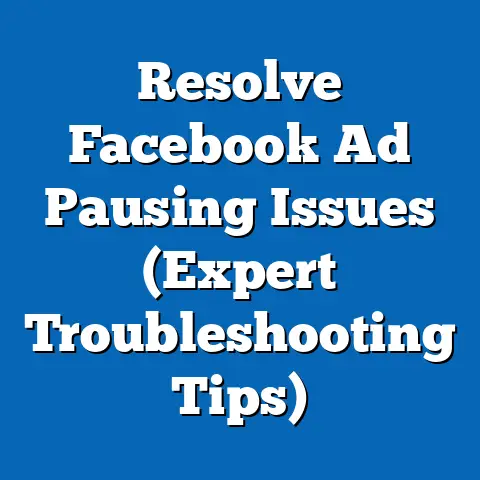Master Facebook Ad ID Verification (Essential Strategies)
In today’s digital advertising landscape, one thing is crystal clear: privacy and authenticity are no longer optional extras, they are the bedrock of successful campaigns. We’re seeing a significant shift, with regulations tightening and consumers becoming more discerning about the ads they engage with. Facebook, now Meta, is at the forefront of this evolution, implementing increasingly robust verification processes. This isn’t just about ticking a box; it’s about building trust, ensuring compliance, and ultimately, maximizing your advertising ROI.
I remember when Facebook ad verification was a relative afterthought. A few clicks, some basic info, and you were good to go. But those days are long gone. Now, verification is a critical step, and failing to navigate it successfully can lead to ad disapprovals, account restrictions, or even permanent bans. This guide is designed to equip you with the knowledge and strategies you need to master Facebook Ad ID Verification, ensuring your campaigns run smoothly and effectively.
Section 1: Understanding Facebook Ad ID Verification
Let’s start with the basics. What exactly is Facebook Ad ID Verification?
Definition: Facebook Ad ID Verification is the process of confirming the legitimacy of your business and your identity as an advertiser on the platform. It’s designed to ensure that the ads users see are coming from real businesses with genuine intentions. This helps combat fraudulent activities, misleading information, and ultimately, creates a safer and more trustworthy advertising environment for everyone.
Why is it important?
- Building Trust: Verification signals to users that you are a legitimate business, increasing their confidence in your brand and your ads.
- Compliance: It ensures you are adhering to Facebook’s advertising policies and regulatory requirements, preventing potential legal issues.
- Access to Features: Verified ad accounts often unlock access to advanced advertising features and capabilities within the platform.
- Avoiding Penalties: Failure to verify can result in ad disapprovals, account restrictions, and even permanent account suspension. I’ve seen businesses lose weeks of momentum because they neglected this crucial step.
How the Verification Process Works:
The verification process generally involves submitting documentation that proves your business and identity are legitimate. This typically includes:
- Business Documents: Business license, registration certificate, tax ID, or other official documents that confirm your business’s legal existence.
- Personal Identification: Government-issued photo ID (driver’s license, passport) to verify your identity as the person authorized to manage the ad account.
- Address Verification: Utility bill or bank statement showing your business address.
- Domain Verification: Proving ownership of the domain associated with your business.
Facebook will review these documents and may request additional information if needed. The process can take anywhere from a few days to a few weeks, depending on the complexity of your case and the accuracy of the information you provide.
Consequences of Not Verifying:
The consequences of neglecting Facebook Ad ID Verification can be severe. You might face:
- Ad Disapprovals: Your ads may be rejected if your account is not verified.
- Account Restrictions: Facebook may limit your ability to run ads, create new campaigns, or access certain features.
- Account Suspension: In severe cases, Facebook may suspend your ad account entirely, preventing you from advertising on the platform.
Takeaway: Facebook Ad ID Verification is a crucial step for all advertisers. It’s not just about complying with Facebook’s policies, it’s about building trust, gaining access to features, and avoiding potentially devastating penalties.
Section 2: Key Strategies for Successful Verification
Now that you understand the importance of Facebook Ad ID Verification, let’s dive into the strategies you can use to ensure a smooth and successful process.
2.1 Preparing Your Business Information
The foundation of a successful verification process is having accurate and consistent business information.
- Accuracy is Key: Ensure that your business name, address, phone number, and website are consistent across all platforms, including your website, social media profiles, and official business documents. Discrepancies can raise red flags and delay the verification process.
- Organize Your Documents: Gather all the necessary documents in advance, including your business license, tax ID, registration certificate, and any other relevant paperwork. Make sure these documents are up-to-date and clearly legible. I recommend creating a digital folder specifically for your verification documents.
- Double-Check Everything: Before submitting your information, double-check everything for accuracy. Even a small typo can cause delays or rejections.
2.2 Understanding Facebook’s Verification Requirements
Facebook has specific requirements and criteria for verifying ad accounts. Understanding these requirements is crucial for a successful outcome.
- Review Facebook’s Policies: Familiarize yourself with Facebook’s advertising policies and verification guidelines. This will help you understand what Facebook is looking for and how to comply with their requirements.
- Know the Accepted Documents: Understand which types of documents Facebook accepts for verification. This information is available in Facebook’s help center.
- Avoid Common Pitfalls: Be aware of common pitfalls that advertisers encounter during the verification process, such as submitting expired documents, providing inconsistent information, or failing to respond to Facebook’s requests in a timely manner.
2.3 Utilizing Facebook Business Manager
Facebook Business Manager is an essential tool for managing your ad accounts and navigating the verification process.
- Set Up Business Manager: If you haven’t already, create a Facebook Business Manager account. This will allow you to manage your ad accounts, pages, and other assets in one central location.
- Navigate to Verification Settings: Within Business Manager, navigate to the “Security Center” or “Business Info” section. This is where you’ll find the option to start the verification process.
- Follow the Instructions: Carefully follow the instructions provided by Facebook. This typically involves submitting your business information, uploading the required documents, and confirming your identity.
- Respond Promptly: Respond promptly to any requests from Facebook for additional information or clarification.
Here’s a step-by-step guide based on my experience:
- Access Business Settings: In your Business Manager, click on “Business Settings” in the left-hand menu.
- Navigate to Security Center: Look for “Security Center” in the left-hand menu.
- Start Verification: If your business hasn’t been verified, you’ll see a section prompting you to start the verification process. Click “Start Verification.”
- Select Your Country: Choose the country where your business is registered.
- Enter Business Details: Provide the legal name, address, and phone number of your business. Ensure this matches the information on your official documents.
- Upload Documents: Upload the required documents, such as your business license or tax ID.
- Verify Your Phone Number or Domain: Facebook may ask you to verify your phone number or domain to confirm ownership.
- Submit for Review: Once you’ve completed all the steps, submit your information for review.
2.4 Building Trust with Customers
Verification isn’t just about complying with Facebook’s policies, it’s also about building trust with your audience.
- Highlight Verification: Once your account is verified, prominently display the verification badge on your Facebook page and in your ads. This signals to users that you are a legitimate business.
- Be Transparent: Be transparent about your business practices and policies. This will help build trust with your audience and demonstrate that you are a reputable advertiser.
- Engage with Your Audience: Engage with your audience on a regular basis, responding to their comments and questions. This will help build relationships and foster a sense of community.
Takeaway: Successful Facebook Ad ID Verification requires careful preparation, a thorough understanding of Facebook’s requirements, and a commitment to building trust with your audience.
Section 3: Overcoming Common Challenges
Even with careful planning, you might encounter challenges during the Facebook Ad ID Verification process. Here are some common issues and how to overcome them:
- Document Rejections: If your documents are rejected, carefully review Facebook’s feedback and determine the reason for the rejection. This could be due to expired documents, illegible scans, or inconsistent information. Correct the issue and resubmit your documents.
- Delayed Verification: If your verification is taking longer than expected, contact Facebook support for assistance. Be prepared to provide additional information or documentation if requested.
- Inconsistent Information: Ensure that your business information is consistent across all platforms. Discrepancies can cause delays or rejections.
- Technical Issues: If you encounter technical issues during the verification process, try clearing your browser cache and cookies or using a different browser. If the problem persists, contact Facebook support.
Case Study:
I once worked with a client who was struggling to get their ad account verified. They had submitted their business license, but it was repeatedly rejected. After some investigation, we discovered that the name on their business license didn’t exactly match the name on their Facebook page. We updated the Facebook page to match the business license, and the verification was approved within a few days. This highlights the importance of ensuring that your information is consistent across all platforms.
Takeaway: Don’t be discouraged if you encounter challenges during the Facebook Ad ID Verification process. Be persistent, address any issues that arise, and seek assistance from Facebook support if needed.
Section 4: The Future of Facebook Ad Verification
The landscape of digital advertising is constantly evolving, and Facebook Ad ID Verification is no exception. Here’s what you can expect in the future:
- Increased Scrutiny: As privacy regulations tighten and concerns about misinformation grow, Facebook is likely to increase its scrutiny of advertisers. This means that the verification process may become more rigorous and require more documentation.
- AI-Powered Verification: Facebook may leverage artificial intelligence (AI) to automate parts of the verification process, making it faster and more efficient.
- Integration with Other Platforms: Facebook may integrate its verification process with other platforms, such as Google and Apple, to create a more seamless experience for advertisers.
- Emphasis on Transparency: Facebook will likely continue to emphasize transparency in advertising, requiring advertisers to disclose more information about their business practices and targeting strategies.
Implications of Evolving Privacy Standards:
Evolving privacy standards, such as GDPR and CCPA, are likely to have a significant impact on Facebook Ad ID Verification. Facebook may need to collect more information from advertisers to ensure compliance with these regulations. Advertisers will also need to be more transparent about how they collect and use user data.
Staying Informed:
To stay ahead of the curve, it’s essential to stay informed about updates from Facebook regarding verification processes and best practices. Follow Facebook’s official blog, attend industry events, and network with other advertisers to stay up-to-date on the latest trends.
Takeaway: The future of Facebook Ad ID Verification is likely to be characterized by increased scrutiny, AI-powered automation, and a greater emphasis on transparency. Staying informed and adapting to these changes will be crucial for success in the long run.
Conclusion
Mastering Facebook Ad ID Verification is no longer optional, it’s a necessity for success in digital advertising. By understanding the importance of verification, implementing the strategies outlined in this guide, and staying informed about future trends, you can ensure that your ad accounts are compliant, your campaigns run smoothly, and your business builds trust with its audience.
Remember, the advertising landscape is constantly evolving. What works today may not work tomorrow. That’s why continuous learning and adaptation are crucial.
Take action today! Review your Facebook ad account, gather your necessary documents, and start the verification process. Don’t wait until you encounter a problem. Proactive verification is the best way to protect your business and ensure your continued success on Facebook. Good luck!






